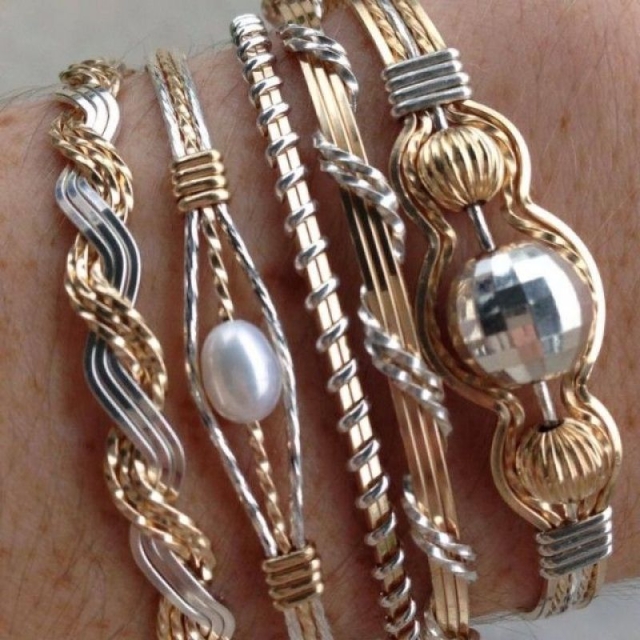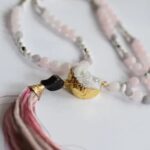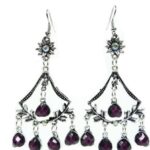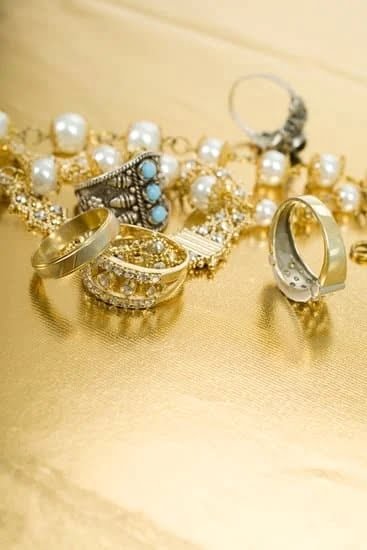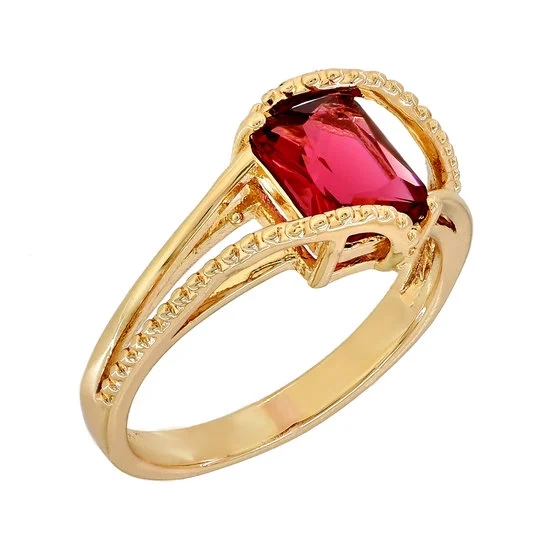Handmade recycled jewelry is a type of accessory you can buy which has been created from recycled materials. It’s a unique, eco-friendly form of jewelry making which gives new life to materials that would otherwise be discarded as waste. Not only does it create beautiful pieces of artisanal craftsmanship and design, but it also helps lessen our impact on the environment.
The Benefits of Handmade Recycled Jewelry Handmade recycled jewelry offers a number of benefits over traditional retail jewelry. One advantage is the lower cost compared with pricey, high-end jewels, making it more accessible to the everyday consumer.
Additionally, because the materials were already being used in another form before being remade into jewelry, the resourcefulness of handmade recycled jewelry helps reduce our environmental footprint in comparison with sourcing new materials for every piece. Despite its relatively low cost, handmade recycled jewelry offers great quality in terms aesthetic appeal; each one-of-a-kind creation has its own unique character and design which can’t be replicated elsewhere.
Variety of Materials Used in Handmade Recycled Jewelry The variety of materials used to create handmade recycled jewelry goes beyond just simple plastics or metals. A plethora of interesting components are utilized such as antique silverware and cutlery, vintage glassware and textiles like sari silks, lace doilies or fabrics from vintage clothing and quilts – creating truly unique designs that no two pieces are exactly alike.
Even electronics such as tablets and other mobile device screens are being mashed up together to make beautiful pieces of artwork otherwise known as tech-jewelry or ‘upcycling electronic waste’. By upcycling these materials into accessories we can reinterpret their soiled history into something more meaningful – a personal reminder that something once discarded has been carefully crafted into something artistic that you can wear proudly yourself.
History of Recycled Jewelry
The practice of recycling precious metals and materials into jewelry has long been a tradition among many civilizations. Beginning with the Egyptians, who recycled bronze to create colorful jewelry pieces, these practices have been passed down from generation to generation.
As time progressed, the understanding of metalworking and design techniques grew, enabling individuals to be more creative in their reuse of scraps. Recycled jewelry was not just something you found on the market – generations crafted intricate pieces with love, creativity and skill in order to save money and show off their craftsmanship.
Environmental Benefits
In today’s world, the use of handmade recycled jewelry has numerous environmental benefits beyond its historical uses. In fact, it can reduce our environmental footprint significantly by reducing pollution from harmful production processes like mining for gold or diamonds.
Every piece of recycled jewelry offers an opportunity to preserve valuable raw materials that would otherwise be consumed in manufacturing new jewelry from scratch. In addition to preserving resources, recycled jewelry is less likely to contain harmful toxins or byproducts normally released through mining operations.
Recycled Jewelry Making
Making handmade recycled jewelry is a precise art that requires a level of skill combined with an eye for beauty and quality as well as patience and time spent honing one’s abilities over time. One must begin by gathering the scrap metal from different sources such as furniture stores, hobby shops or even flea markets before sorting out what’s needed for the desired project based on color, size and shape.
Next comes filing down the collected material into smaller pieces which can then be hammered together to begin forming shapes for earrings, necklaces, pendants and other pieces.
The final step involves welding connections between pieces so they fit properly while hand polishing each piece when complete This tedious process is part of creating stunning artwork from upcycled materials which gives real value in both money savings as well as eco-friendly benefits compared to traditional methods used in mass production factories.
Benefits of Upcycling
Upcycling is an excellent way to create beautiful, eco-friendly jewelry that everyone can enjoy wearing. It helps reduce the amount of waste entering landfills and reduces our impact on the planet. Upcycling jewelry also provides many other practical benefits:
- High Quality – When done properly, upcycled jewelry can be just as good quality as any manufactured piece.
- Unique Appearance – Handmade recycled jewelry items are one-of-a-kind pieces that often cannot be replicated elsewhere.
- Affordable Prices – Upcycling jewelry doesn’t have to be expensive, making it a great choice for budget shoppers who want something special.
The materials used to make handmade recycled jewelry also provide additional advantages over mass produced pieces. By repurposing old or unused items, these pieces contain fewer resources and energy used compared to traditional products. They can also potentially last longer as they are not subject to the same wear and tear that minimum wage assembly lines encounter.
One type of upcycled material used in today’s marketplace is plastic upcycling. By using already existing plastic products, such as water bottles and packaging film, artisans are able to turn them into stunningly intricate works of wearable art without requiring new materials or chemicals be created. This has helped open up possibilities for those looking for unique pieces without sacrificing their environmental values.
Another popular option is metal upcycling, where scrap metal from various industries is utilized in creating rings, necklaces and earrings with intricate detailing through various processes such as hammering and etching. This approach allows artisans to craft eye-catching pieces without relying on traditional valuable metals like silver or gold which can sometimes be difficult to procure in comparison. The result is a cost effective yet surprisingly durable alternative with plenty of design customizations available.
Sources
Handmade recycled jewelry is becoming more and more popular as people learn to upcycle materials like paper, plastic, fabric scraps, and metal into fashionable pieces of wearable art. To make the most sustainable jewelry possible, it is important to look at which sources provide the best material for repurposing.
Thrift Stores: Good for Fabric
One great source of reusable materials are thrift stores. Thrift stores provide a variety of gently used items that can be transformed into unique jewelry. This includes fabric scraps from clothing like old dresses or t-shirts that can be cut and sewn into small shapes and embellished with beads or other decorative elements. This is a great way to get creative with apparel you would have normally discarded.
Yard Sales: Cans for Crafting
Yard sales are another great place to find items for turning into handmade recycled jewelry. Items such as tin cans can be easily transformed by cutting them in creative ways and adding colorful paint or ornamental decorations. This same technique can also be done with old pottery fragments for even more utility. These items can be painted, layered with other metallic components, glued on stones or stringed onto threads to make colorful necklaces and bracelets.
Hardware Stores: A Wealth Of Inspiration
Hardware stores are also a great resource when searching for materials to craft recycled handmade jewelry out of odd everyday objects such as chains, hinges, bolts, nuts, screws etc Metal in general from hardware stores can easily be adapted by cutting small details from different pieces then soldering them together with more intricate designs shaped from copper wire.
Shopping around at these types of shops often results in unique ideas not found elsewhere since these places specialize in offering an enormous amount of different types of hardware supplies.
Creative Ideas for Recycling Jewelry
Recycling old jewelry into brand new accessories is a great way to get creative and show off your unique style. It can be quite fun to look for creative ideas for reusing old pieces of jewelry, as there are many possibilities with what you can do.
One popular option is to repurpose pieces of jewelry by using them in different ways than intended. This could involve turning a necklace into earrings, for example, or taking an antique brooch and turning it into a pendant. This allows you to get really creative and make something completely unique with the items you have on hand.
Not only does this save money, but it’s also environmentally friendly. Other ideas include stringing together multiple pieces of jewelry to create an interesting necklace or pendant, and creating charms out of beads, buttons, charms, etc.
Another way to repurpose your old pieces of jewelry is by upcycling them. This involves taking existing pieces and transforming them into something else entirely. Examples of such transformations include refashioning a ring by adding stones or other decorative elements; transforming a bracelet into beautiful earrings; updating the style of an older bracelet; or repurposing several necklaces into one statement piece.
Upscaling your jewelry not only gives it a fresh look, but it also increases its value as well since you’re creating something completely new out of materials that were previously discarded. Plus it feels incredibly rewarding when you get to enjoy the stunning creations created from your recycled treasure trove.
Old jewelry often holds sentimental value for many people so instead of throwing away these mementos they can be transformed into something that can be worn proudly. With just few supplies like glue, pliers and some wire – even beginners can take their old treasures and turn them into new wonderous works of art that will surely make heads turn with admiration.
So try out these creative ideas for recycling jewellery today – not only will you give new life to old jewellery but also help reduce waste while saving yourself some money in the process.
Upcycling Tips
Recycled jewelry can be a fun and creative way to express yourself while taking part in environmentally friendly practices. There are many items that can be repurposed or reused to create unique pieces. Some of these items include bottle caps, paper clips, buttons, wristbands, and beads. With a bit of creativity and the right tools, you can create one-of-a-kind recycled jewelry.
When it comes to upcycling jewelry, there are several tips to consider in order to get started on your project. First, choose a material that is durable and easy to shape or manipulate. Common options include leathers or plastics (such as acrylics).
Once you have chosen your material, start by deciding which design elements you want to incorporate into the piece – its shape, color or pattern – so you can find suitable materials or supplies to build it with. It’s also helpful to research tutorials online for advice on how assemble your piece. Finally, make sure you set aside enough time; upcycling projects take some trial and error and may require extra trips out for supplies if needed.
When it comes to finishings such as clasps and fasteners, careful consideration will help ensure that the end product will be sturdy and secure. Use heavy duty threads or wires when stitching together Jewelry pieces together; this helps them stay in place during normal wear without coming apart easily. Additionally, make sure clasps fit securely but don’t require too much effort to pop open; otherwise customers may not want to purchase it for daily use.
Overall creating handmade recycled jewelry is an engaging activity both at home or in the classroom. Making something new from already existing material is an eco-friendly choice that allows us reduce our consumption of natural resources while adding a personal touch into our accessories collection at the same time.
Challenges of Working with Reclaimed Materials
Recycled jewelry provides a unique way for designers to create beautiful pieces while making an environmental statement. Making use of discarded and recycled materials for jewelry-making comes with a few challenges, however. The primary issue is finding the right materials.
For instance, if one wants to make jewelry from scrap metals or wood they may need to scour junkyards, antique shops, estate sales or other places where vintage items are sold in order to find usable materials. This can be time consuming and tedious work as not all reclaimed items will be suitable.
Identifying Quality Materials
Once suitable materials have been located it can be difficult to determine if the pieces are indeed quality resources. When working with higher-end materials such gold and sterling silver, it can be hard to tell if these spaces have been treated properly by their previous owner.
There are numerous techniques that skilled jewellers can use when examining their pieces such as testing the material’s purity with acid or having it appraised by a professional. It is important that an experienced jeweller takes these steps in order to provide their customers with high-quality goods which will stand up over time and wear.
Structural Integrity
Another challenge faced when making recycled jewelry is ensuring structural integrity of the piece once the material has been shaped into its desired form. Jewelers need to inspect their pieces thoroughly looking for any flaws which might cause breakages over time due to normal wear and tear from daily activities such as bathing or exercising.
Particular attention should be given when incorporating different types of material into one piece of jewelry – for example stone set into metal – as not all surfaces are compatible leading to weak spots which could result in damage over time. This is especially true when integrating different precious metals together so appropriate soldering techniques must be used in order for this type of jewelry making project succeed smoothly.
DIY Projects for Making Handmade Recycled Jewelry
Creative crafting is an enjoyable way to express yourself, and handmade, recycled jewelry projects are a great way to get started. Recycled materials can be found in abundance, and they lend themselves to upcycling for stylish accessories that you can wear or give as gifts. When it comes to creating your own unique pieces of jewelry, here are some exciting DIY projects for handmade recycled jewelry at your doorstep.
Layovers
Creating oversized earrings out of everyday items such as plastic plates or candies wrappers is the perfect project for sprucing up old jewelry or creating something special from reused materials. All you need is a pair of scissors to cut out the shapes and glue them together with E6000 glue before adding jump-rings, hooks or any other type of hardware that will fit onto the piece.
Media Beads
If you’ve been collecting scraps of fabric, beads and buttons, then media beads are just the project you need. Put those little pieces together to make colorful earrings or necklaces – small square tiles glued together into larger squares work well too. An added bonus with this project is that it looks best when mismatched so feel free to include weird beads and fabrics too.
Beaded Braids
Beaded braids don’t have to be complicated – simple enamel wire wrapped around colorful cords will do. With loose ends on each side, attach jump rings onto them and use crimp covers with chain links attached to create makeshift chains that serve as a boho-style necklace closure. And if you’re feeling brave enough, add charms along the beaded braid for extra charm even when wearing a plain tee.
4
Repurposed rings add character and charm into any outfit. Use old bottle caps or lids from cans to create statement rings – paint them in whichever colors you prefer before punching holes in the middle using a hole puncher tool for fitting in ring blanks (the strips used by people who tap bottles). Now grab your favorite hardware embelishments like charms or pins to glue onto one side of the ring blank for additional pizzazz.
Gallery of Handmade Recycled Jewelry Designs
The following list contains some of the most stylish handmade recycled jewelry designs available:
- Button Bracelet – This design utilizes a mixture of colorful, vintage buttons for a unique and fully customizable bracelet.
- Bottle Cap Earrings – Made from 100%-recycled materials, these earrings are created by punching holes into colorful bottle caps and connecting them with wires.
- Wire Wrap Hair Stick – A must-have accessory for any eco-friendly fashionista. Use one or two of these wrapped copper sticks to keep your hairstyle looking sleek and hip.
- Rivet & Chain Layering Necklace – Using upcycled materials like metals, this necklace captures both a rustic yet modern look. It features rivets and chain in various lengths that layer for an eye catching addition to any outfit.
- Foil Wrapped Cufflinks – Simple yet sophisticated, these cufflinks feature recycled aluminum foil that has been molded and manipulated into petite shapes. These accessories will help dress up any shirt cuff.
When browsing through various collections of handmade jewelry, it is easy to find an array of pieces made from recycled materials. Not only are they stylish, but they create less waste while providing beautiful fashion statements. In fact, many contemporary artisans are leading the way in creating innovative designs that combine old world craftsmanship with modern sensibility.
One example is designer Kelsey Wyatt’s unique upcycling technique. Utilizing debris washers from electronic components, she twists and wraps them into tiny sculptures – perfect for wearing as necklaces or bracelets. With color choices such as silver or gold the outcome ranges from subtle elegance to a bold urban style.
As people become increasingly aware of the impact their choices have on the environment more shoppers are choosing pieces that utilize recycled materials. In states where ecologically friendly initiatives are emerging this trend is quickly gaining traction as awareness spreads about its potential benefits not just for individuals but also eco systems around the world.
Inspiration
When looking to purchase handmade or recycled jewelry, there are a number of options available. Some people may even be inspired to create their own pieces from reclaimed materials or items. To show the range and potential of these impressive designs, here are some examples of handmade recycled jewelry:
- Upcycled fabric necklace – Using intricate stitching techniques, various colors of fabric scraps can be combined into one eye-catching necklace.
- Recycled leather earrings – Taking discarded leather scraps, they can be cut into a variety of shapes and sizes to make elegantly designed earrings.
- Compacted paper jewelry – Tear up different types of used paper and glue them together prior to sculpting it into fun rings or pendants.
- Reuse Leather Cord Bracelets – Using several feet of old surplus leather cord (preferably black) twine the two ends in looping knots for an earthy looking bracelet.
- Wooden bead necklaces – Vintage beads can be found on Etsy or flea markets with some being more than 50 years old. These beads can be put onto thread, string or ribbon that’s been hand dyed in expressive colors for unique results.
Recycled vintage buttons decorated with wire wrapping can also add stylish embellishments to any piece while providing a vibrant look with interesting stories behind them. Natural stones such as rough jasper, turquoise chrysocolla or smoky quartz strands are great accents for additional necklace designs. Repurposed materials such as watch parts, gears and keys can also provide something special when making this handmade jewelry.
Rather than throwing away used items, it’s possible to find new life in them when making handmade recycled jewelry. By searching antique shops and thrift stores there is no way you cannot find memory invoking items which could become something meaningful through creating one-of-a-kind pieces. Whether using scrap metal from office supplies or charms made by friends – adding components that have sentimental value provides undeniable character.
Trends and Techniques for Designing Recycled Jewelry
Recycled jewelry has become increasingly popular in recent years, and for good reason. It’s eco-friendly, unique, and allows creative individuals to express their own style with the materials around them. As a result, there are many trends and techniques surrounding this type of jewelry design that have been gaining traction since its inception.
Upcycling Materials
Upcycling, also known as creative reuse, is the process of taking discarded or unwanted items and recycling them in an inventive fashion to create something new and useful. For example, vintage buttons can be used to make earrings or pendants. Other upcycled materials commonly used in recycled jewelry include recyclable plastics such as yogurt cups, soda cans, bottle caps, wood fragments, and shells.
Additionally, kitchen scraps like corks and nut shells have been transformed into beautiful pieces of statement jewelry. Creative DIYers often give life to old electrics by turning them into clocks or knick-knacks displayed on necklaces or bracelets.
Reddot Projects
Red Dot Projects serve as another popular technique utilized when making a recycled jewelry piece as it focuses on using unique terminals without soldering for added convenience. This approach takes neglected objects – think broken pencils, bent paper clips – and utilizes sanding tools in order to shape them into one’s desired item: be it an earring back or a pendant charm.
Sometimes colored lacquers are then applied for extra pizzazz. There’s something special about wearing one-of-a kind gifts handcrafted from a single source – whether it comes from nature or reused trash – that gives us assurance we’re doing something big to help the environment (while looking fashionable).
Alternative Refinements
For those more experienced with handmade jewelry making techniques, adding alternative finishes like hammering flat metal pieces can add visual texture while still emphasizing an eco-friendly ethos. Dyeing fabrics of different colors for use in jewelry is also another must try technique; you can quickly dye your own scrap fabric with food coloring or other safe dyes found at craft stores before using it to create an entirely distinctive color palette perfect for pins and patches.
One way many creators go about adding custom flare to these pieces is through freehand etching with drills or burnishers – this allows for precise detailing on metals without devouring too much time away from overlooking other aspects of construction.
Benefits of Supporting Handmade Recycled Jewelry
Supporting handmade recycled jewelry is a great way to show you care for the environment and also add some personal style to your wardrobe. Handmade recycled jewelry is a statement of uniqueness and originality that you won’t find in a store bought piece. Supporting handmade recycled jewelry can also be beneficial to local craftspeople who are trying to make an honest living and may not have access to traditional materials used for commercial pieces.
Handmade recycled jewelry often uses materials that are already available, such as re-cycled metals and re-purposed items like clothes buttons, bottle caps or even found objects from nature like rocks or seashells. By using these materials, craftspeople are reducing waste while creating something new and different.
Often times these pieces are more affordable than the commercial alternatives since they don’t require any extra material costs beyond what would normally be discarded anyway. By supporting handmade recycled jewelry, buyers help in reducing the need for mining raw materials for use in manufacturing jewelry by providing another source of durable metal from old machinery or broken items of jewelry that can be melted down into usable form.
In addition, handmade recycled jewelry provides a unique opportunity to truly make something personal and distinctive as well as giving it meaning through the symbolism associated with recycling; being conscious about one’s environmental footprint, respect for materials, preserving resources and creative reuse of what was previously considered “garbage.”
This message can especially resonate with many given current efforts on sustainability on a global level; purchasing handcrafted items gives consumers the assurance that their money is going directly to supporting artists and helping them create pieces that reflect their values – which cannot always be said regarding anonymous mass produced items.
Benefits of Purchasing and Selling Handmade Recycled Jewelry
Handmade recycled jewelry has become increasingly popular in the fashion world. Not only does it provide customers with fashionable and stylish accessories, it is also beneficial to the environment. This article will discuss the various benefits of purchasing and selling handmade recycled jewelry.
Environmental Benefits
One of the biggest advantages of purchasing and selling handmade recycled jewelry is its environmental benefits. The use of sustainably sourced materials such as copper or up-cycled tin cans reduces the overall environmental impact of producing these pieces.
The area where the materials are sourced from can also benefit from lowered emissions since these products do not require burning fossil fuels during production or transportation. Moreover, recycling existing materials into new products helps minimize manufacturing waste which helps keep our environment cleaner for future generations.
Economic Benefits
The economic benefits of purchasing and selling handmade recycled jewelry cannot be ignored either. When an individual chooses to buy a piece from a local artisan, he or she is directly supporting that artist’s business which in turn allows them to grow their skills and profits.
On top of this, buying locally crafted pieces helps boost local economies since none of the money needs to go overseas in order for these items to be made available on the market. Furthermore, purchasing and selling the pieces directly impacts family incomes as artisans usually come from underprivileged backgrounds allowing them to create a better life for themselves and their families.
Consumers Benefits
Not only does buying handmade recycled jewelry affect others in a positive way, it also encourages consumers to become more conscious about their fashion choices by choosing eco-friendly accessories over traditional mass-produced ones that harm our planet in various ways throughout production and transportation processes.
Additionally, wearing something special like this makes somebody feel unique knowing that no one else has exactly what they have – even when multiple people incorporated similar ideas into designing their pieces each one will be distinctively tailored according to each artist’s own style preferences resulting in one-of-a-kind items being created every time.
Conclusion
When talking about handmade recycled jewelry, we must consider the process from start to finish. It involves spending time and energy to upcycle materials from places like antique shops, flea markets, and thrift stores.
However, the results bring delight and make for beautiful, one-of-a-kind accessories that look good and reduce environmental waste. The pieces are created using various formulations of scrap metal, wood, glass stones, fabric scraps and plastic materials that have been cleaned and combined with contemporary items.
The eco-friendly jewelry created in this way is highly valuable it not only celebrates creativity but looks great too. Furthermore these accessories can be easily customized to fit any occasion or lifestyle preference while still preserving their earth-friendly spirit making them the perfect item for those who want to make a statement while looking good at the same time.
Finally by wearing handmade recycled jewelry you’re not only adding some personality to any outfit but also supporting viable economic ecosystems which promote sustainability practices as well as artists who are devotedly dedicated to their craft. It’s a fantastic way of doing your part in helping the planet without compromising on personal style or individual expression.

Welcome to my jewelry blog! My name is Sarah and I am the owner of this blog.
I love making jewelry and sharing my creations with others.
So whether you’re someone who loves wearing jewelry yourself or simply enjoys learning about it, be sure to check out my blog for insightful posts on everything related to this exciting topic!

